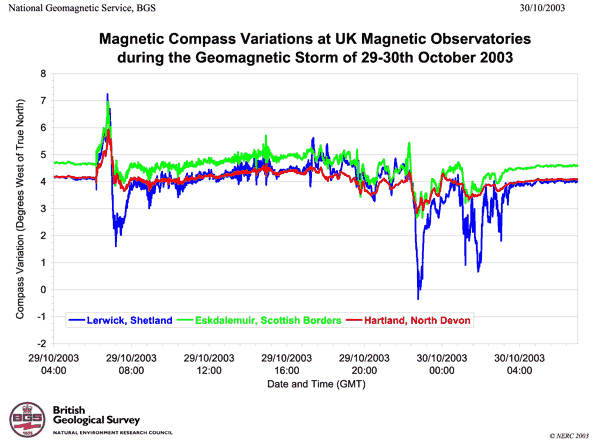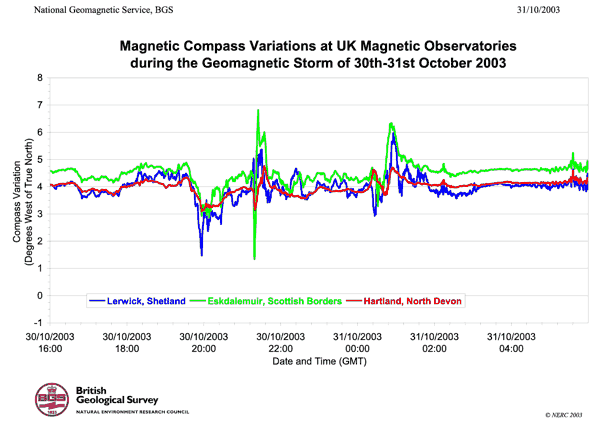Largest Geomagnetic Storm in 20 Years
Latest News
Update: 31st October 2003
A second powerful coronal mass ejection impacted the Earth's magnetic field at around 1600GMT on 30th October. Subsequently a large magnetic storm with strong auroral displays was observed. Aurora sightings would have been possible from all over the UK (weather permitting). The compass direction temporarily changed by over 5 degrees in only 6 minutes (!!) across central Scotland at about 2120GMT last night.
Although activity has died down since about 0400GMT today the storm is not necessarily finished. The solar wind still has the potential to restart geomagnetic activity later on today. Finally, the solar sunspot region that has caused all this excitement is still magnetically complex and will continue to pose a threat for the next few days.
The storms and aurorae of the last few days are certainly up there with the best in the last few decades at least!
Posted: 10:10GMT 30th October 2003
The geomagnetic storm peaked again between 16:00GMT on the 29th and 04:00GMT on the 30th. A maximum in intensity across Central Scotland was observed between 20:00 and midnight. Auroral displays were marked. A long, slowly drifting, east-west green curtain was observable from the south of Edinburgh in the Pentland hills, with occasional flashes of bright red. Car passengers on the Edinburgh city bypass were able to see a green-tinged sky overhead.
And it may not be over! The Sun again significantly erupted at 20:49GMT on the 29th October, suggesting a further geomagnetic storm and possible auroral displays perhaps as soon as the early hours of 31st October.
Did you see the aurora last night? Post your sightings to us!
Posted: 29-Oct-2003 18:00GMT
At 1110GMT on 28th October 2003 a major solar flare took place from a Sunspot group directly in line with the Earth. This event, measured at X17.0 on the astronomers' Richter-like scale of magnitude, was one of the top three flares in the last few decades. Subsequently a coronal mass ejection was observed to leave the Sun in the direction of the Earth. The magnitude of the solar eruption was such as to temporarily disable one of the instruments on the NASA spacecraft ACE that is designed to observe such events. A major geomagnetic storm commenced at 0611GMT today (29th October) in response to the solar event. Already, activity has reached the top of the geomagnetic K-scale of measurement. In the UK, peak activity has already been similar to the great storms of the last twenty years. The compass variation at Lerwick changed by 5.1 degrees in only 25 minutes at about 0630GMT. We cannot however say for certain how this magnetic activity will change in the coming hours. The variations that occur during magnetic storms are notoriously difficult to predict. However activity at these levels may intermittently continue for one to three days, with peaks in the UK most likely during the night time hours. The societal impacts of such an event are varied. During nighttime, the aurora may be seen in clear skies throughout the UK, even to the South of England. Already, auroras have been reported in the Southern USA. Major solar and geomagnetic storms may pose problems for satellites, spacecraft and astronauts. Power and pipeline grids may be affected.
Compass Variations
Please click here for a PDF version of the above image.
Please click here for a PDF version of the above image.
Aurora Sightings
Have you seen the aurora this week? Post your sightings to us!
Here are what some people saw:
Aurora viewing outside Peebles
"We got great sights of it last night! Got home at 7:45
to great dynamic curtains of green, and stayed outside for 45 min
with the kids. Checked again later a few times, and were rewarded
with an incredible green and red light show at 10 pm!"
Margarete Heck 29th October 2003
"Having been alerted of the event by my magnetic observatory
in Livingston and via the usual alerts on the web. We went to Blackford
hill in Edinburgh and observed a really good auroral display between
2200 and 2300 on the 29th. The low horizon over Edinburgh was obscured
by cloud but the green glow was very prominent with arcs extending
to well over 90 degrees vertical (estimated 70 degrees elevation
from south) No red flashes seen during this period."
Stephen Thomas 29th October 2003
"In spite of heavy broken cloud, I was able to observe
aurora from the moors above Skipton, N. Yorks., last night between
about 20:00 and 02:00 this morning. The display took the form of
a greenish-grey radiance in the northern sky which resembled the
pre-dawn light, and in spite of the cloud-cover at times was almost
bright enough to cast shadows. Later, at about 01:00, the clouds
above the horizon started to break up, revealing some shimmering
vertical filaments, and patches of dark red glow."
Peter Duffy 29th October 2003
Location: Blackford Hill, Edinburgh looking north.
Date: 29 October 2003 Time: 21:55 to 22:15
"The lights were first evident as pale streamers directly
overhead, but during the period of observation manifested as luminous
green cloud, broad rays, wavering curtains spanning the entire horizon,
and a central point of quite strong luminosity (equivalent to hazy
moonlight) with rays fanning out."
Hazel Martin
"Aurora seen from a hill nr Starcross nr Exeter. Seen at
21:15 A bright green glow to the north with stars faintly visible
with red areas appearing and disappearing over a minute or so. Thin
straight white streaks like con trails appeared and disappeared
near the zenith. Later on 23:30 to 00:30 similar without the white
streaks except a red curtain shape appeared with vertical red streaks.
This area extended from NW to NE again with green glow to the north.
The red was still visible about 05:00."
David Moore 30th October 2003
Scientific Background
The Sun has a magnetic field like the Earth. However the Sun is a ball of gas and because the Sun's atmosphere at the equator rotates faster than at the poles the Sun's magnetic field can become twisted and stressed. Sunspots are a manifestation of this stress. A coronal mass ejection may then occur to locally relieve the magnetic stress and carry twisted magnetic fields and matter out into space. This is what happened yesterday. The Sun has an approximately eleven-year cycle of magnetic activity but this peaked about two years ago. The Sun has been relatively quiet for the last twelve to eighteen months but it has been magnetically active for over a week now. When a coronal mass ejection travels directly to the Earth a geomagnetic storm may occur. The mass ejection may take between one and four days to reach the Earth, so yesterday's event was exceptionally quick and powerful. The Earth's magnetic field then responds to the passage of the "solar storm". Some of the matter, fields and energy in the mass ejection may be transported into the Earth's magnetic field, the "magnetosphere", driving electrical currents that, for example, power the Aurora Borealis (Northern Lights). The rapid variations in the electrical current systems of the Earth's magnetosphere may also induce electric fields in the ground that can cause currents to flow through low-resistance conducting networks such as power grids and pipelines. The energetic particles in the current systems of the magnetosphere may cause electrical disruption to satellites and spacecraft and may temporarily affect GPS accuracy, satellite positioning and HF communications.
Dr Alan Thomson
Geomagnetism
British Geological Survey
Edinburgh



